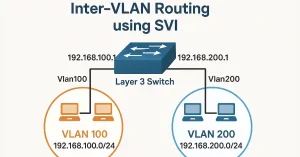What is Switch Virtual Interface (SVI) – Everything to Know
Switch Virtual Interfaces (SVIs) are a cornerstone of modern enterprise networking, enabling efficient inter-VLAN routing on multilayer switches. This guide, designed for CCNA and CCNP students, explores the evolution of Layer 2 and Layer 3 switching, SVI configuration, verification, troubleshooting, and real-world applications. Whether you’re preparing for certification exams or deploying networks, this article provides […]

